 |
|
|
|
| HISTORY
Santorini's wild beauty and volcanic landscape distinguish it from the rest of the Cyclades. It present shape is what remained after the sinking of the Kaldera (Crater) of the (now extinct) volcano, which is encircled by the islets of Thirasia and Aspronisi. In antiquity it was called Stongyli (round) or Kallisti (most beautiful) and was first settled by Phoenicians. |
|
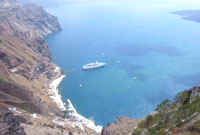 |
|
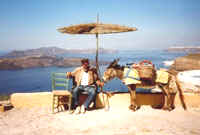 |
|
Inhabited since prehistoric times, it flourished during the early Cycladic period and afterwards, as shown by the excavations at Akrotiri. All its prosperity came to an end, however, with the eruption of the volcano around 1600 BC. At the start of the first millennium Dorian colonists settled there and the island took a new name, Thera, after their leader. Subsequently special contacts were developed with Cyprus, Crete, Asia Minor and several regions on the Greek mainland. |
|
| Allied with Sparta until 426 BC when the island joined the Athenian Confederacy, it was used as a refuge from the Ptolemis because of its location, falling into decline during the Roman era. Its strategic location was again of importance during the Byzantine Empire. From 1207 it belonged to the Dukes of Naxos and was governed by a series of Venetian lords (Barozzi, Crispo, Pisani). |
|
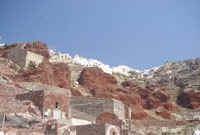 |
|
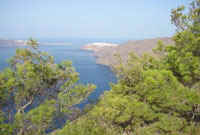 |
|
Despite its good fortification, it still suffered frequent pirate raids. It was ceded to losiph Naxis and in 1579 fell to the Turks. In 1821 it took an active part in the Revolution and shipping brought it considerable prosperity in the later 19th century. The long Latin occupation left its mark on the political and economic organization of the island, and Western influence can also be seen in the large numbers of Catholics among the population. |
|
| SIGHTSEEING
Fira, the island's capital, is built along the upper slopes of the west coast. It is linked to the harbor by a steep, stepped road and by cable car, from which one has a superb view over the harbor and shoreline. Its houses are built in a style unique to the island. |
|
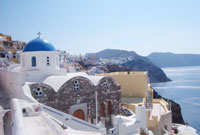 |
|
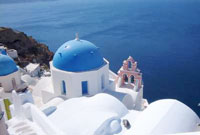 |
|
Small, dazzlingly white, with numerous windows and vaulted roofs they present a stunning picture, in which the larger mansions and the Archeological Museum stand out. At the Dominican monastery there is a weaving school and cultural center. |
|
| The Catholic cathedral is located near the monastery, while the Orthodox cathedral is in the southern part of town. The aristocratic families used to live at Imerovigli where there are ruins of old mansions and the monastery of Agios Nikolaos (1674). Skaros is the site of one of the island's most important fortresses. Abandoned in the 17th century, this was the mediaeval capital. From Fira Bay one can take trips to the volcano, Nea Kammeni and Old Kammeni, where there are hot springs. |
|
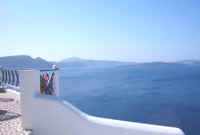 |
|
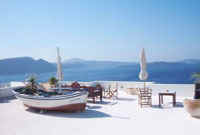 |
|
Akrotiri in the southern tip of the island was the site of the prehistoric city of Thera. Excavations have brought to light an entire city with houses, streets, squares and workshops that churches of the Virgin stin Trypa and Agia Anna, as is Pyrgos with its Byzantine church Theotakaki (10th c.). At Mesa Gonia, another Byzantine church, the 11th century Episkopi, containing valuable icons and distinctive frescos has been preserved. |
|
| The monastery of the Prophitis Elias (18th c.) has a collection of holy treasures and also operates a folk museum and icon-painting studio. At Megalohori are the ruins collapsed when the volcano erupted. At the village named La Ponte by the Venetians are the ruins of another fortified castle, with two churches. Mesa Vouno, on the other hand, is the site of ancient Thera. |
|
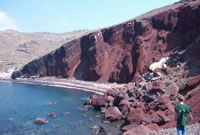 |
|
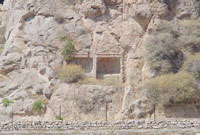 |
|
Here one can see the ruins of the agora, theater, public and private buildings, but of the finds an Archaic clay idol, completely intact, is the most impressive. The village of Vothonac is very picturesque with its of a little 3rd century BC temple. La and Finikia on the north ridge of the island are two of Santorini's most attractive settlements, their white-washed houses a brilliant contrast to their vividly painted vaulted roofs. |
|
| Most of the beaches on Santorini have black sand and pumice pebbles, a result of their volcanic origin. Kamari and Perissa are among the best. Though the south coast lends itself better to swimming and water sports, there are beaches in the north at La, Ammoudi and Armeni. Small boats leave La for excursions to the islet of Thirasia opposite. Santorini's unsual landscape, its distinctive architecture, the wealth and diversity of its monuments attract floods of visitors particularly in summer. |
|
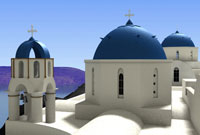 |
|
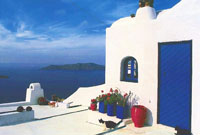 |
|
As a result accommodation is hard to come by at this time, despite the ample number of rooms and hotels. For all its popularity, Santorini's beauty and charm have not been affected. The island offers both cosmopolitan pleasure and simple delights in its far-flung villages. Hotels to satisfy all tastes abound and taking a room in a private house will acquaint the visitor with the islanders' unforgettable hospitality. |
|
|
 |
|
|
|